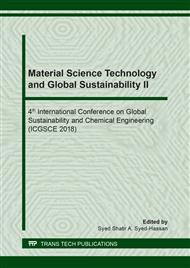[1]
F. M. Fakhouri, D. Costa, F. Yamashita, S. M. Martelli, R. C. Jesus, K. Alganer and F. P. Collares-Queiroz, Comparative study of processing methods for starch/gelatin films,, Carbohydrate Polymers, vol. 95, no. 2, p.681–689, (2013).
DOI: 10.1016/j.carbpol.2013.03.027
Google Scholar
[2]
A. M. Mohd Amin, S. Mohd Sauid and K. H. Ku Hamid, Polymer-Starch Blend Biodegradable Plastics : An Overview,, Advance Materials Reserach, vol. 1113, pp.93-98, (2015).
DOI: 10.4028/www.scientific.net/amr.1113.93
Google Scholar
[3]
P. Liu, L. Yu, X. Wang, L. Chen and X. Li, Glass transition temperature of starches with different amylose / amylopectin ratios,, Journal of Cereal Science, vol. 51, no. 3, p.388–391, (2010).
DOI: 10.1016/j.jcs.2010.02.007
Google Scholar
[4]
M. G. A. Vieira, M. A. da Silva, L. O. dos Santos and M. Beppu , Natural-based plasticizers and biopolymer films: A review,, European Polymer Journal, vol. 47, no. 3, p.254–263, (2011).
DOI: 10.1016/j.eurpolymj.2010.12.011
Google Scholar
[5]
M. N. S. Makhtar, M. N. Muhd Rodhi, M. Musa and K. H. Ku Hamid, Thermal Behavior of Tacca leontopetaloides Starch-Based Biopolymer,, International Journal of Polymer Science, vol. 2013, pp.1-7, (2013).
DOI: 10.1155/2013/373854
Google Scholar
[6]
O. Das and A. K. Sarmah, Science of the Total Environment The love – hate relationship of pyrolysis biochar and water : A perspective ☆,, Science of the Total Environment, vol. 512–513, pp.682-685, (2015).
DOI: 10.1016/j.scitotenv.2015.01.061
Google Scholar
[7]
A. M. Mohd Amin, S. Mohd Sauid, K. H. Ku Hamid and M. Musa, Biodegradation Behaviour of Thermoplastic Starch Films Derived from Tacca leontopetaloides Starch under Controlled Composting Condition,, IOP Conf. Series: Materials Science and Engineering, vol. 358, pp.1-6, (2018).
DOI: 10.1088/1757-899x/358/1/012050
Google Scholar
[8]
A. A. Shah, F. Hasan, A. Hameed and S. Ahmed, Biological degradation of plastics: A comprehensive review,, Biotechnology Advances, vol. 26, pp.246-265, (2008).
DOI: 10.1016/j.biotechadv.2007.12.005
Google Scholar
[9]
T. Leejarkpai, U. Suwanmanee, Y. Rudeekit and T. Mungcharoen, Biodegradable kinetics of plastics under controlled composting conditions,, Waste Management, vol. 31, no. 6, pp.1153-1161, (2011).
DOI: 10.1016/j.wasman.2010.12.011
Google Scholar
[10]
C. Vijaya and R. M. Reddy, Impact of soil composting using municipal solid waste on biodegradation of plastics,, Indian Journal of Biotechnology, vol. 7, pp.235-239, (2008).
Google Scholar
[11]
H. Ismail, R. Abdul Majid and R. Mat Taib, Effects of Soil Burial on Properties of Linear Density Polyethylene (LDPE)/Thermoplastic Sago Starch (TPSS) Blends,, Pertanika Journal of Science & Technology , vol. 19, no. 1, pp.189-197, (2011).
DOI: 10.1080/03602559.2010.482081
Google Scholar
[12]
A. Khan , P. Savi, Q. Simone, M. Rovere, M. Giorcelli, A. Tagliaferro, C. Rosso and C. Q. Jia, Low-Cost Carbon Fillers to Improve Mechanical Properties and Conductivity of Epoxy Composites,, Polymers, vol. 9, pp.1-14, (2017).
DOI: 10.3390/polym9120642
Google Scholar
[13]
P. Douglas, S. F. Tyrrel, R. P. Kinnersley, M. Whelan, P. J. Longhurst, A. L. Hansell, K. Walsh, S. J. T. Pollard and G. H. Drew, Predicting Aspergillus fumigatus exposure from composting facilities using a dispersion model: A conditional calibration and validation and calibration,, International Journal of Hygiene and Environmental Health, vol. 220, no. 1, pp.17-28, (2017).
DOI: 10.1016/j.ijheh.2016.09.017
Google Scholar
[14]
M. Karamanlioglu, A. Houlden and G. D. Robson, Isolation and characterisation of fungal communities associated with degradation and growth on the surface of poly (lactic) acid (PLA) in soil and compost,, International Biodeterioration & Biodegradation , vol. 95, pp.301-310, (2014).
DOI: 10.1016/j.ibiod.2014.09.006
Google Scholar


